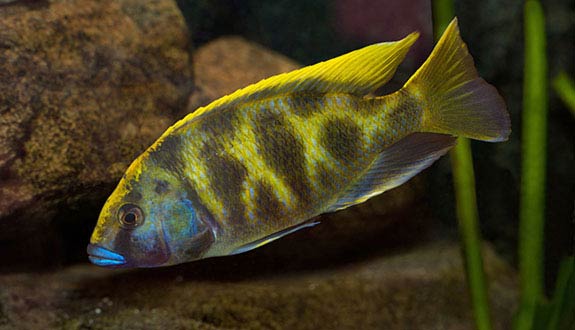

Alternative species (click on the thumbnail to see the card)
Names
Scientific name
Nimbochromis venustus
Cyrtocara venusta
Haplochromis simulans
Haplochromis venustus
Nimbochromis venustus
Common name
Venustus
Venustus hap
Giraffe hap
Giraffe Cichlid
Pfauenmaulbrüter (DE)
Origin

Origin: Africa (Lake Malawi)
Biotope: African
Dimorphism

The male has on its forehead a yellow spot that goes on through all the dorsal fin
Group

Cichlidae
Volume

500 L / 110 imp gal / 130 US gal
Parameters

T°: 24 à 27°C or 75 to 81°F
pH: 7 to 7.5
Hardness: 5 to 15°dGH
Difficulty

Easy
Size

25 cm (10")
Longevity

10 years
Living zone

Depth
Individuals

3 (harem)
Food
How to feed the Venustus?
Food
How to feed the Venustus?
The venustus is piscivorous, so it eats fish.
In captivity, it rarely accepts flakes and other freeze-dried foods from stores. Instead, give him fresh or frozen food. For example, give him fish meat, mussels (cooked) and shrimp.
Behavior
What kind of behavior does the Venustus have?
Behavior
What kind of behavior does the Venustus have?
This fish enjoys the presence of its congeners, but we must respect a few rules. Your group must absolutely be made of a harem, so 1 male for 2 females at least.
The venustus has a strong temper and will jealously defend its territory and its babies. Moreover, if the volume of the aquarium is not adapted, it can kill the other fish that often seek to escape it, by exhausting them until death.
If you get your male venustus young, you will see him gradually take all the beautiful colors that characterize it, like the famous yellow on the dorsal fin.
Cohabitation
Who can live with the Venustus?
Cohabitation
Who can live with the Venustus?
You will have to be careful about the associations you propose to your Venustus. Indeed, this fish has a strong temperament and it shows it! Cohabitation with this species can be tricky.
The dominant male Venustus can become tyrannical with other occupants of your aquarium who also have territorial temperaments, especially during the breeding season when conflicts may arise. To limit the risks, prefer non-territorial species.
Faced with this temperament, choose robust roommates able to defend themselves, and especially not timid and fearful fish that will surely die. For example, non-territorial fish from the Lake Malawi will make good roommates.
Tip: For a community aquarium, introduce all the other fish that make up your desired population before the Venustus. Thus, it is accustomed to their presence when it arrives: it accepts them and lives more easily with them. In the opposite case, the Venustus gives a hard life to newcomers to its territory and eats the smaller fish...
Breeding
How to breed the Venustus?
Breeding
How to breed the Venustus?
During the breeding season, the temperament of the male is even more assertive, and it becomes extremely grumpy, fiercely defending its territory (even more than usual!). Following a love parade, the eggs are laid, fertilized and gathered in the mouth of the female. There may be between 40 and 120 eggs.
The female will keep its eggs in the mouth for about 3 weeks. Throughout this period, she hides and does not eat anymore. After their birth, the fry are protected by the parents during the first months of growth.
Its aquarium
Which aquarium for the Venustus?
Its aquarium
Which aquarium for the Venustus?
The Venustus must be kept in an aquarium of at least 500 liters or 110 Imp Gal or 132 US Gal: this allows the well-being of your fish but also of all the other occupants.
As it is a pretty good swimmer, it needs a large free-swimming zone, especially along the front of the aquarium.
To reduce the risk of aggression in your population, think carefully about the layout of your stones in the aquarium: clearly delineate areas to facilitate the juxtaposition of the territories of your fish.
The floor of your aquarium must be composed of sand and limestone rock.
Good To know
Find all additional information!
Good To know
Find all additional information!
Sexual dimorphism with colors only appears on adult fish. Indeed, the beautiful colors of the male appear during its growth and are not visible on young fish.
Yours photos!
Comments
Sort by:
Please login to post comments

